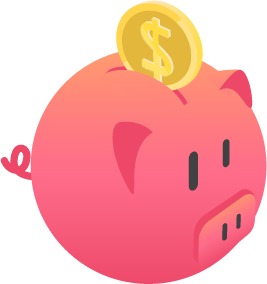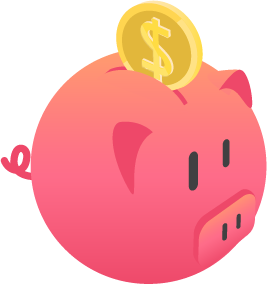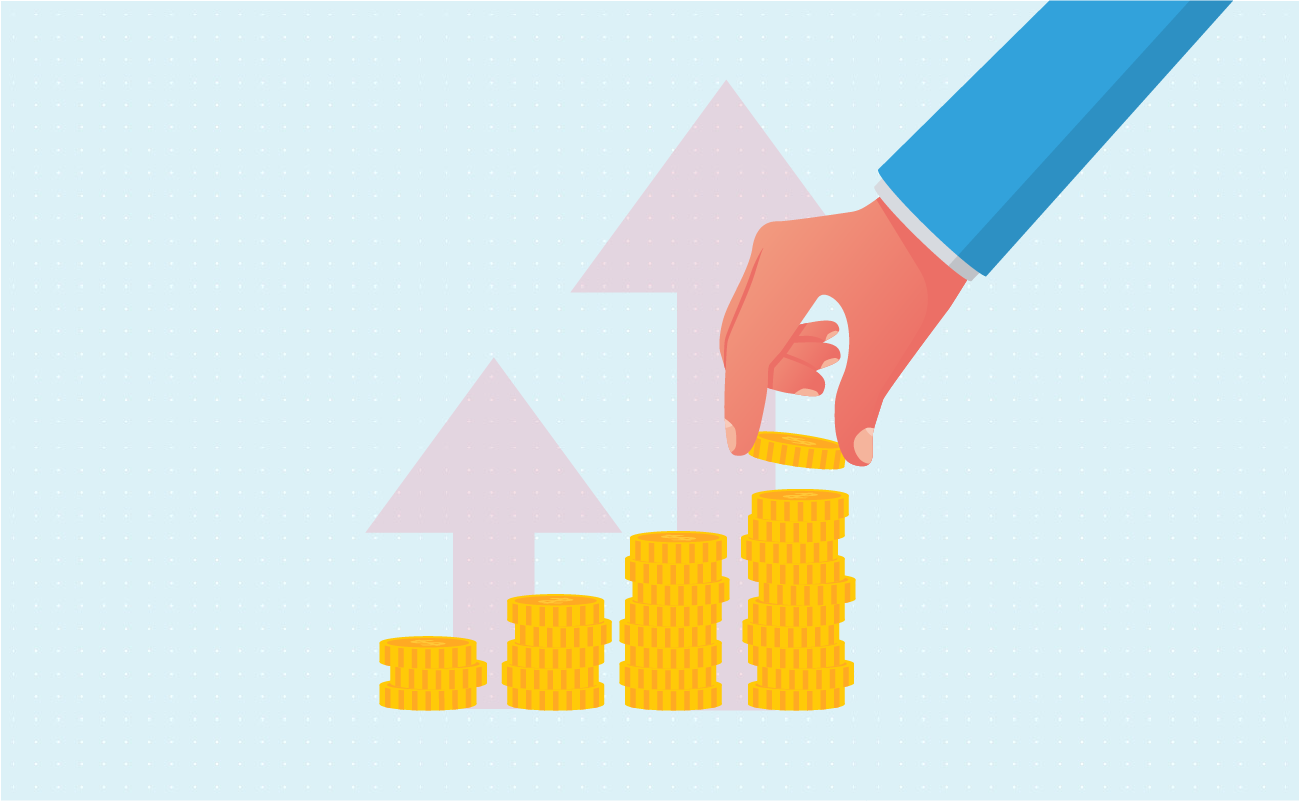Savings Goals
Net Worth
 Required Savings Deposit Calculator
Required Savings Deposit CalculatorUse this calculator to figure how much you would need to deposit today to have your investment grow to a specific goal amount in a set number of years. For example, if you wanted to pay for your child's education, you can see how much you would need to set aside today in order to cover their future education expenses.
This calculator can be used to figure compound interest, or to estimate the projected returns of various other asset classes based on their historical performance.

529 education savings plans can allow you to set aside money for a child's qualified education expenses. These investments can compound on a tax-advantaged basis.
Guide published by Jose Abuyuan on October 28, 2020

When people think about saving money, they see it as an active effort. Indeed, the best ways to earn a fortune is to make your savings a regular, predictable thing. Moreover, you can cut out a lot of time from your goals by placing it somewhere that earns interest. Savings accounts and investments alike can take away some of the effort involved in earning money.
By earning interest, your money goes to work for you. Even the simplest of savings accounts will provide you a modest return with time. And you don’t even need to keep depositing to watch this happen. With a large initial investment, you can put your savings goals on autopilot.
When saving, it is important to have goals in mind. You won’t always have the luxury of saving for everything all at once. Starter salaries can only get you so far. By focusing on one at a time, you can divert all your money to accomplish it in an efficient manner.
Consistency is the key to achieving your savings goals. Dedicate a part of your take-home income to savings alone. This way, you have a predictable amount of money coming in. This dependable amount is crucial to reaching your savings goals on schedule. It doesn’t matter how small your savings amount is at first. You only need to make these contributions on a regular basis.
A budget for savings is critical to measuring the feasibility of each of your goals. But your cash flow isn’t the only thing working in your favor. Where your money goes also matters. A savings account or investment portfolio puts your money to work for you.

A savings account is the simplest of investments. It, like other investments, is a loan in reverse. You, the investor, take the place of the lender, while the institution you entrust with your money is the borrower.
All investments pay for businesses in exchange for a cut of the profits. From the perspective of the lender, loans are an investment on you and your ability to repay. In the same way, you invest in an institution’s ability to make you money. You lend an institution money by opening an account and depositing your cash. Over time, they must pay you back with interest, the fee they owe you for handling your money.
How much interest you can earn depends on three key factors:
The formula varies depending on the type of investment, but the general rules are the same. The higher any of these factors are, the more interest you earn. Some of the best ways to earn more interest is to have a larger principal or wait a longer time.
You have two ways of building wealth through investing. You can increase the size of your principal over time by making periodic deposits. Likewise, you can save your money and put it in your investments all at once.
You might think that the right savings increment is a matter of simple math. And if you don’t have a bank account yet, it probably is. Divide your savings goal either by the amount you can save or the number of months you need it done.
For instance, you want to save for a $25,000 starter emergency fund and can spare $500 a month. If you just stashed it at home, here’s how long it’ll take you to save for it:
= $25,000 / $500 per month
= 50 months
It’ll take you four years and a month to earn that amount outside a bank. Now let’s factor in interest. Putting your money in a savings account cuts down the time you need to meet your goal. Each time you save money, you also earn interest on a monthly basis.
Returning to our previous example, let’s say you stashed your cash in a savings account with a 2 percent annual percentage yield (APY). Using our savings goal timeline calculator, let’s see how long it’ll take to reach your target amount.
Starting Principal: $0
Goal: $25,000.00
Rate (APY): 2%
Monthly Deposit: $500
| Category | Value |
|---|---|
| Number of Deposits | 48 |
| Term | 4 Years |
| Total Amount Deposited | $24,000.00 |
| Interest Earned | $1,006.09 |
| Final Amount | $25,006.09 |
By saving in a bank, you’ve shaved off two months from your target savings goals and earned an extra $1,006.09. This, of course, assumes that you plan on making several regular deposits.
You might also imagine earning all your money this way. It can, in fact, be done. This is one of the larger goals of retirement planning. All your savings accumulates to create a large enough fund that’ll earn money for you with little to no effort on your part.
Moreover, through the magic of compound interest, it becomes possible to put your savings on autopilot. A large lump sum deposit can, with enough time, grow the money to a desired amount all by itself.

Great minds like Benjamin Franklin have said wonderful things about compound interest. In simple terms, it is interest applied to interest. The money you’ve earned during an incrementing period merges with your principal. This larger amount earns more interest, which adds to your balance. It goes on as long as the money stays in the account. The longer the money remains, the more interest it can earn.
The most spectacular results come when you keep depositing money into your savings. Because your principal keeps growing, so do your earnings. But even a small sum can grow if you leave it to compound. If you prefer, you can put in a larger one-time lump sum and leave it to work.
When building wealth, compound interest and time are your greatest allies. Long time horizons yield the greatest possible yields through compound interest. This is why it is said that the best time to save and invest was yesterday. The second best time is today.
It is also important to follow one of the most important rules in finance: don’t touch the capital. The more your money is left alone to compound, the more it works for you.
But as the rules say, it takes money to make money. The challenge of lump sum saving is that you need a large starting principal to begin with. You can earn for this amount as usual, through monthly increments in a savings account. But once you’ve reached that goal, it’s time to place it in the account and wait.
Let’s say that you want to earn $300,000. Your investment plan offers a maximum yield of 7 percent and compounds each year. You’d want to meet your goal in about 20 years. To achieve that, here’s how much you’ll need to contribute as a lump sum.
| Category | Value |
|---|---|
| Savings Goal | $300,000 |
| Rate | 7% |
| Term (Compounding Frequency) | 20 Years (Compounds annually) |
| Lump Sum Deposit | $77,525.70 |
| Effective APY | 7% |
To meet your goals within two decades, you need to save at least $77,525.70 all at once.

Be careful before making a lump-sum contribution to 529 investment funds Depending on the state, a 529 fund waives gift taxes on contributions up to a maximum of $30,000. In our example, you may need to pay these lump sums in three annual increments to remain tax efficient.
Of all the factors involved in earning interest, rates are the most important. Borrowers seek out the lowest rates they can afford to save on long-term payments. Investors, meanwhile, search for the highest rates to maximize their profits. The rate of return is also one of your greatest allies in long-term investing. To grow your earnings, you need a rate that outpaces the rate of inflation.
It’s tempting to go for the investment that offers the highest rates of return. Not so fast, there! Rates have a caveat. The more they promise, the riskier they are to invest in. If you’re not careful, you can invest in risky assets and lose more money than you expected to make.
The highest returns often come from the riskiest investments, and vice versa. A savings account in the bank, for instance, is one of the safest places to invest. However, it’s also the worst when it comes to returns. Stocks are the riskiest investments you can make in the short term. They also provide you with the best long-term returns.
How assets perform varies over both short and long-term time horizons. While they appear erratic over shorter time spans, they are quite predictable over several years. For instance, Visual Capitalist outlines the performance of several asset classes between 2010 and 2019.
| Asset Class | Annualized Return |
|---|---|
| Global Commodities | -5.38% |
| Emerging Markets Equity | -0.89% |
| Treasury Coupons | 0.73% |
| Investment Grade Bonds | 3.17% |
| Hedge Funds | 4.05% |
| Corporate Bonds | 5.55% |
| Global Listed Private Equity | 5.59% |
| 1-5yr High Yield Bonds | 6.71% |
| Global Equity | 6.75% |
| Global Equity – ESG Leaders | 6.87% |
| Taxable Municipal Bonds | 7.20% |
| Real Estate Investment Trusts | 8.44% |
| U.S. Mid Cap Equity | 11.00% |
| U.S. Large Cap Equity | 11.22% |
| Dividend-Paying Equity | 11.81% |
| U.S. Small Cap Equity | 11.87% |
And that’s just data from the past decade. Meanwhile, a comprehensive Harvard study tracked the performances of four key asset classes over the course of over half a century. The table below outlines the performance of these asset classes between 1950 and 2015. The authors adjusted the rate of return according to inflation.
| Asset Class | Real Rate of Return |
|---|---|
| Treasury Bills | 0.88% |
| Bonds | 2.79% |
| Equity (Stocks) | 8.30% |
| Housing (Real Estate) | 7.42% |
Long-term patterns hold for a reason. Follow the time-tested patterns for your main investment strategy. However, don’t be so quick to discount short-term trends. After all, historical trends do not always reflect likely future performance. In the short term, the stock market might fluctuate too many times for your comfort. Thus, you must tailor your investment strategy according to your personal risk profile.

All investments have risks involved. Even money-based investments, which are often among the safest, are vulnerable to inflation. To minimize your risks when investing, it is vital that you keep your portfolio diversified.
Diversification is putting your eggs in more than one basket. In investing, it refers to owning more than one asset type at any given time. This is the same principle why large corporations seem to own a lot of different companies. When one business underperforms, the others that profit make up for it. The same applies to your investment portfolio.
Each asset class makes up for the weaknesses of the others. When one underperforms, your other assets pick up the slack. Over the short term, money assets guarantee an immediate return to hedge against the volatile profits of stocks. In time, stocks will outperform your money assets and generate much of your profits.
Diversification also makes your portfolio resilient. Even in the event of a downturn, it is unlikely that every asset in a diverse portfolio will underperform. The stable assets will preserve some of the value of your investments until things turn up again.
To make diversification work for you, you must choose your mix of assets based on your risk tolerance. This is called asset allocation. Based on your risks, you invest a specific percentage of your money on each asset class. No person has an identical risk profile. Some people are more tolerant of market fluctuations and short-term losses than others. Your risk profile will also change over time, prompting the need to re-allocate your assets.
There are two major factors affecting risk tolerance. The one most familiar to laypeople is age. Young people have time on their side, which allows them to throw money into stocks and other risky assets. The set and forget strategy will work in their favor for a very long time. Older adults, meanwhile, do not have long before they retire. They don’t have the same time buffer to weather against risks. But because they will spend their savings sooner, they aren’t as affected by inflation.

The Rule of 110 is one way to gauge your asset allocation based on age. Subtract your age from 110. The difference will be the percentage you invest in stocks. If you’re 30, for instance, your allocation would be 80 percent stocks and 20 percent bonds and cash investments.
The other major factor is financial stability. One study found that finances might have a greater impact on a person’s ability to invest. Most young people, for instance, do not have a lot of money to risk. Thus, as first-time investors, they might overwhelmingly favor conservative investing strategies. Older adults have more money to risk. Thus, they can invest more aggressively in stocks.
Over time, you might need to change your portfolio’s asset allocation. Circumstances may change your risk tolerance. As your finances stabilize, you might want a more aggressive strategy. Other times, the market might be a bit bullish, causing your shares to grow in value too much, putting you at risk.
Reallocation is a simple process. Buy more of one asset type or sell excess ones to achieve the appropriate ratio of stocks and bonds. Do remember that there might be tax consequences when you sell. Ask a professional to help you manage your tax burdens when reallocating.

If you ever came across windfall money or have accumulated a lot of savings, you’d be wise to invest that money. But should you go all in at once or invest it slowly? If you’re entering the volatile world of investing in stocks, there’s no clear answer that works for everyone.
Investing little by little has its advantages when investing in stocks. This strategy, known as dollar-cost averaging, lowers the amount you pay each time you invest. Here, you buy stocks at regular intervals regardless of its current market price.
Markets fluctuate. You might buy fewer stocks in some intervals and more in others. In uncertain times, this might work to your advantage. Let’s say you have $50,000 to invest. By dividing that amount into five $10,000 increments, you can invest it all within a span of five months. The amount your money will buy will vary from month to month. Let’s imagine that this is how the markets performed in those five months:
| Month | Amount | Stock Price | Stocks Bought |
| January | $10,000.00 | $330 | 30 |
| February | $10,000.00 | $350 | 28 |
| March | $10,000.00 | $310 | 32 |
| April | $10,000.00 | $270 | 37 |
| May | $10,000.00 | $220 | 45 |
| Total | $50,000.00 | 172 |
In total, you’ve bought 172 stocks. If you invested in January, you’d only have bought 151. You might be kicking yourself for not waiting until May, but that’s a moot point. You could play the waiting game, but you have no way of knowing the price decreases that are coming your way. In fact, the prices during June might be even lower (or higher).
Unpredictability, however, favors the people who invest in lump sums. During a bull market, for instance, stocks would only go up. Each subsequent investment yields you fewer stocks than if you bought them all at once. Research shows that lump-sum investing vastly outperforms dollar-cost averaging, and with good reason.
But don’t discount incremental investing just yet. As we’ve brought up before, personal finance is as much choosing the strategy that fits your behavior. If you tend to be risk-averse, lump sum investments might not be the wisest move. Dollar-cost averaging can help you break out of that rut without putting you in undue risk.
Always assess your own risks before investing. Just because you have time horizons on your side, doesn’t mean you should be reckless with your money. Caution and prudence are what separates investors from gamblers. You can always reallocate your assets later as your financial situation stabilizes.
Evaluate your financial situation and tailor your savings and investment strategy from there. Make room in your budget for a regular stream of savings. Cultivate the necessary discipline to keep setting aside that money. While you’re at it, put your immediate needs first. If you’re starting out or are struggling with debt, prioritize saving emergency funds or paying off high-interest debts. Begin investing by taking on more low-risk investments like bonds.
Remember, investing is a long game. Regardless of how you invest, the important thing is that you keep your money in your portfolio. The longer you keep your money invested, the greater the rewards as your money compounds. Let time be your ally toward financial security.
Smarter goal-setting can put you on the path toward long-term financial stability. Want to see how long it’ll take to meet your savings goals? Drop by our savings goal calculator.
Jose Abuyuan is a web content writer, fictionist, and digital artist hailing from Las Piñas City. He is a graduate of Communication and Media Studies at San Beda College Alabang, who took his internship in the weekly news magazine the Philippines Graphic. He has authored works professionally for over a decade.